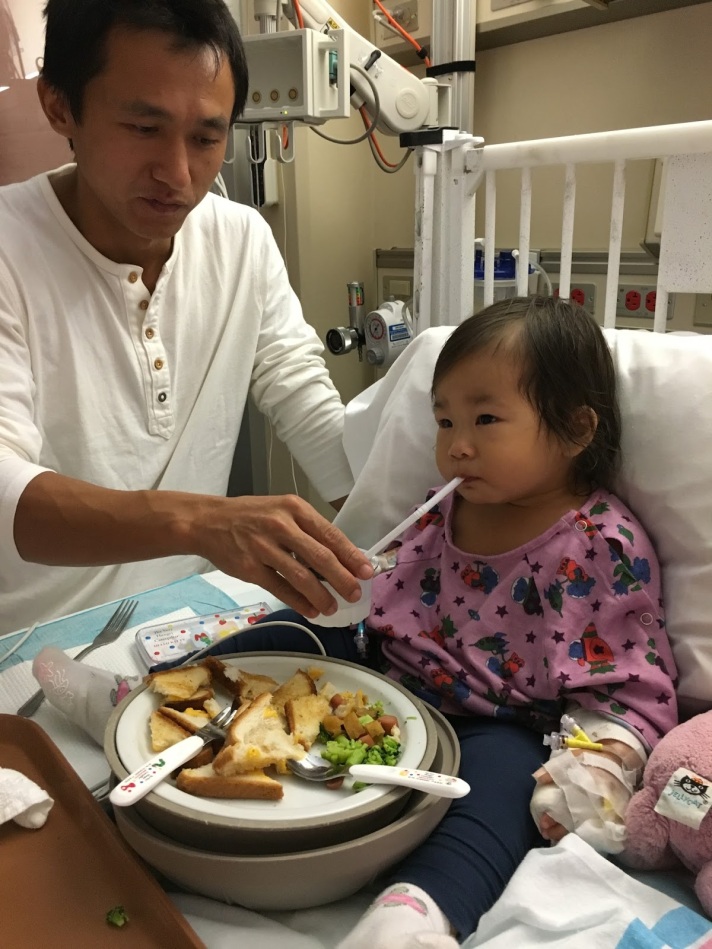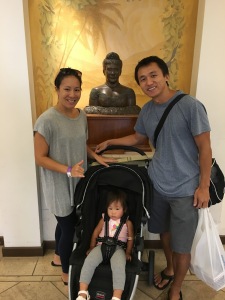Coral was diagnosed with Type 1 diabetes on Friday, March 11, 2016 at nearly 16 months of age. Three days prior, I had noticed she was very lethargic, peeing heavy diapers, wetting her bed, and super thirsty. I never knew these were classic signs of T1d – nobody ever tells you that! I had emailed her pediatrician Thursday evening with my concerns. Friday at 8:00am PST, Dr. Quensell calls and asks, “Where are you?” I put my fork down and struggled to swallow a bite of sunny-side-up eggs. “Just finishing up breakfast,” I replied hesitantly. “I need to see Coral right now,” and we hung up the phone. My husband, was just about to leave for work with his foot out the door. I told him, “That was Dr. Quensell, it isn’t good. You should come with us.”

Then, they said she’s in Diabetes Ketoacidosis (DKA), a severe and life-threatening diabetes complication where the body has built up high levels of acidic ketones due to the lack of insulin. Without enough insulin, your body cannot breakdown glucose and begins to use fat for energy to fuel your muscles and tissues. DKA is fatal if the patient does not receive immediate medical care and hospitalization. Even after diagnosis, a diabetic can go into DKA with uncontrolled high blood glucose levels (example: failed pump site or lack of managing T1d responsibly OR rationing their insulin due to lack of affordability and/or accessibility). Type 1 diabetes is no joke.
We were overwhelmed with emotions and loads of information as they brought us up to the PICU. We would stay there for the next 24 hours so they could monitor her and met Dr. Uramoto that afternoon. He was the one who formally diagnosed Coral with “diabetes,” which is when I had to ask, “Well, which type?” Growing up around my mom’s boyfriend who has Type 2 diabetes, I was familiar to seeing him inject insulin on the couch right before he ate handfuls of peanut M&Ms.
“Type 1,” Dr. Uramoto replied. My heart sank and tears began to overflow once more as I turned to hug my husband. At that point, I knew she would be insulin-dependent for life. Nurses would periodically enter the room to check her blood sugars and give insulin via IV if needed, but they were still figuring out her correction factor. If they gave her too much insulin, her blood sugar would drop too low and they’d come back rushing in with some juice. If they gave her too much juice, she would spike or go high again and the process would repeat until they finally narrowed it down. Anyone who’s T1d knows that this pattern of constant highs and lows will wreck you – physically, mentally, and emotionally. Now, can you imagine what my baby girl was going through the first two days?
By 9:00pm PST, we were all extremely exhausted, barely hungry, and in need of a shower. My husband went home first to freshen up and pack a weekender bag of our things and shortly returned with some food. I went back home close to 11:00pm that same night to shower and grab a few other toiletries. He and I both slept on a single pull-out chair next to Coral’s hospital bed and waking intermittently almost every hour as nurses came to check on her.
The following morning, Coral began to feel a little better and the nurses said she’d be able to eat an actual meal instead of relying only on fluids. The menu selection sucked – grilled cheese sandwich, cheeseburger and fries, or oatmeal. We weren’t exactly sure how a high-carb diet can effect blood sugars at the time, but never fed her these types of foods at home to begin with. I made a lot of stir-frys served with rice. We love Hawaiian food – lau lau, lomi salmon, poi, kalua pig and cabbage with rice. All super carby, but we always tried to stay away from fried foods and rarely ate any fast-food.
Please note: Type 1 diabetes is an autoimmune disease not a lifestyle disease. There is nothing that person or their parents did or could’ve done to prevent or cause this chronic condition. Basically, the body’s immune system attacks the pancreas, destroying the insulin-producing beta cells making them insulin-dependent. They cannot outgrow or “reverse” it and need daily doses of insulin either by injection or pump therapy. Anyone at any age can get T1d. Those numbers are increasing across the globe every year. There is no known cure at the moment, no thanks to greedy pharmaceutical companies.
By Saturday afternoon, they moved us down to the Wilcox Ward where we met her new Diabetes Team. They asked us what pace was good for us to learn and we said as straight-to-the-point as possible. We loved how compassionate and sympathetic CDE, Nurse Drizza Tabisola was as she covered more topics on diabetes management from short-term to long term. Dr. Uramoto stopped in periodically and instructed us how to give proper insulin doses with a syringe by practicing with an orange. I volunteered to go first and by that evening, I gave Coral her first injection with a steady hand. My hubs mustered up his courage as he battled with shaky hands and emotions to give her an injection. I knew from that day forward, I would have to stay home to care for her while he continued working as an underpaid medical researcher and professor at a local medical center.
Come Sunday and she was shaking her booty in her oversized purple hospital gown and diaper to Pandora on my iPhone in the room as if it was just any other day. She said “Hi” to anyone passing by or entering our room and even made some quick friends with other kids in the playroom. They released us that Monday, March 14, 2016 in the afternoon and sent us home with some diabetic supplies (insulin vials and pens, syringes, alcohol swabs, etc). As we walked to the car, we were just as nervous and – if not, more scared then we were when we took her home as a newborn infant. We knew our lives would never be the same and that we would have to adapt quickly and continue learning as much as possible in the next few weeks if we were to ensure her survival and a full healthy life. We have no other choice, but to be strong for #adorablecoral.
BOTTOM LINE: Don’t ignore any of these warning signs and trust your gut. It is not silly of you to call your pediatrician or PCP if you or your child are experiencing any of these symptoms:
- lethargy
- extreme thirst
- frequent urination
- bed-wetting or heavy diapers (for toddlers and young children)
- fruity breath odor
- blurry vision
- weight loss – I never realized it at the time, but looking back at pictures of Coral in February compared to March 2016, she had lost some weight
- vomitting or nausea
- loss of consciousness (aka slipping into a diabetic coma, likely fatal)
- rapid heavy breathing
Dr. Uramoto is the only pediatric endocrinologist in the entire State of Hawaii. We’re so thankful for him, Nurse Drizza, and his team for empowering and giving us a practical, straight-forward approach to managing T1d from that day forward. I remember him asking us what our educational backgrounds were and that’s why he didn’t hesitate to breakdown insulin to carb ratios (I:C), insulin on board (IOB), BG target, giving insulin injections, counting carbohydrates, and all the other bare necessities of learning how to manage this damn disease from the get-go. I’d also like to give a big mahalo (thank you) to Dr. Josephine Quensell for her knowledge, expertise, and sense of urgency upon receiving my inquiry. If she hadn’t contacted me immediately, one day longer would’ve been too late.


One thought on “Our Diagnosis Story”